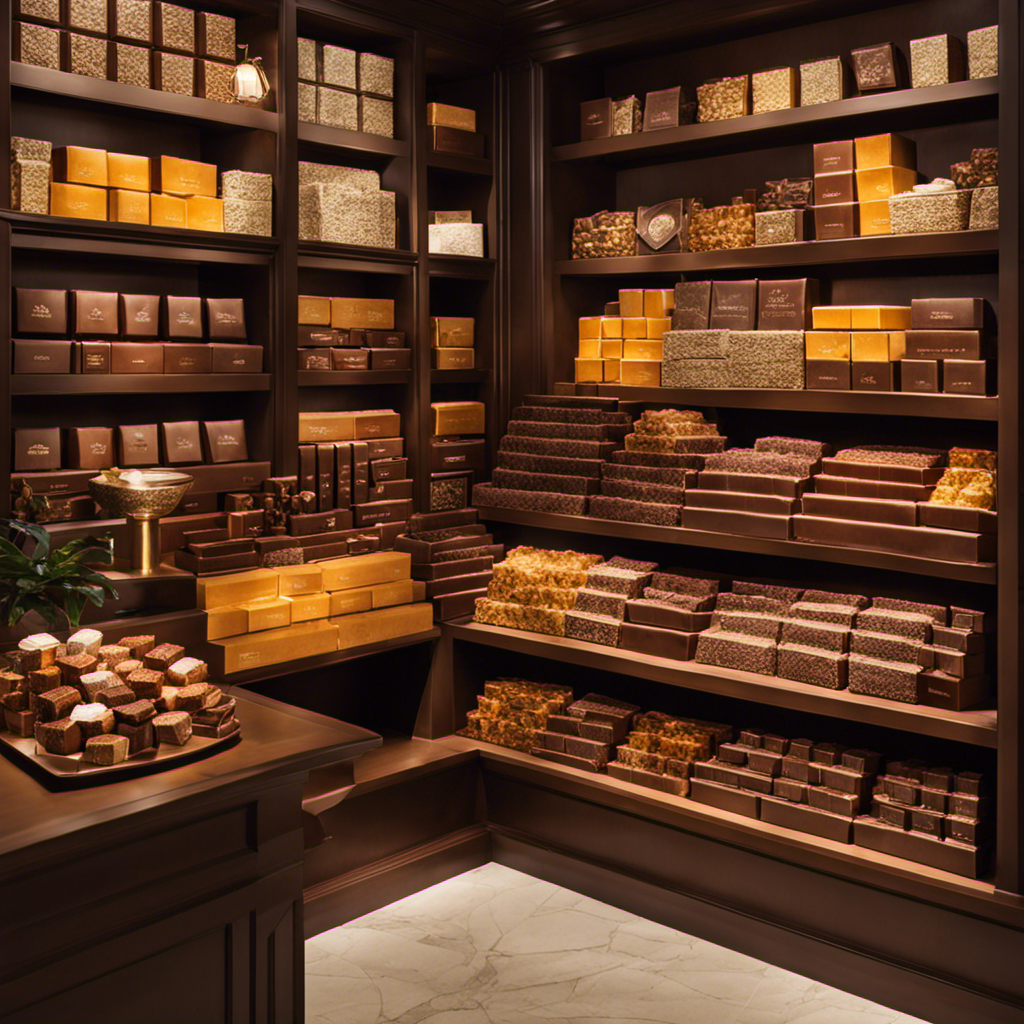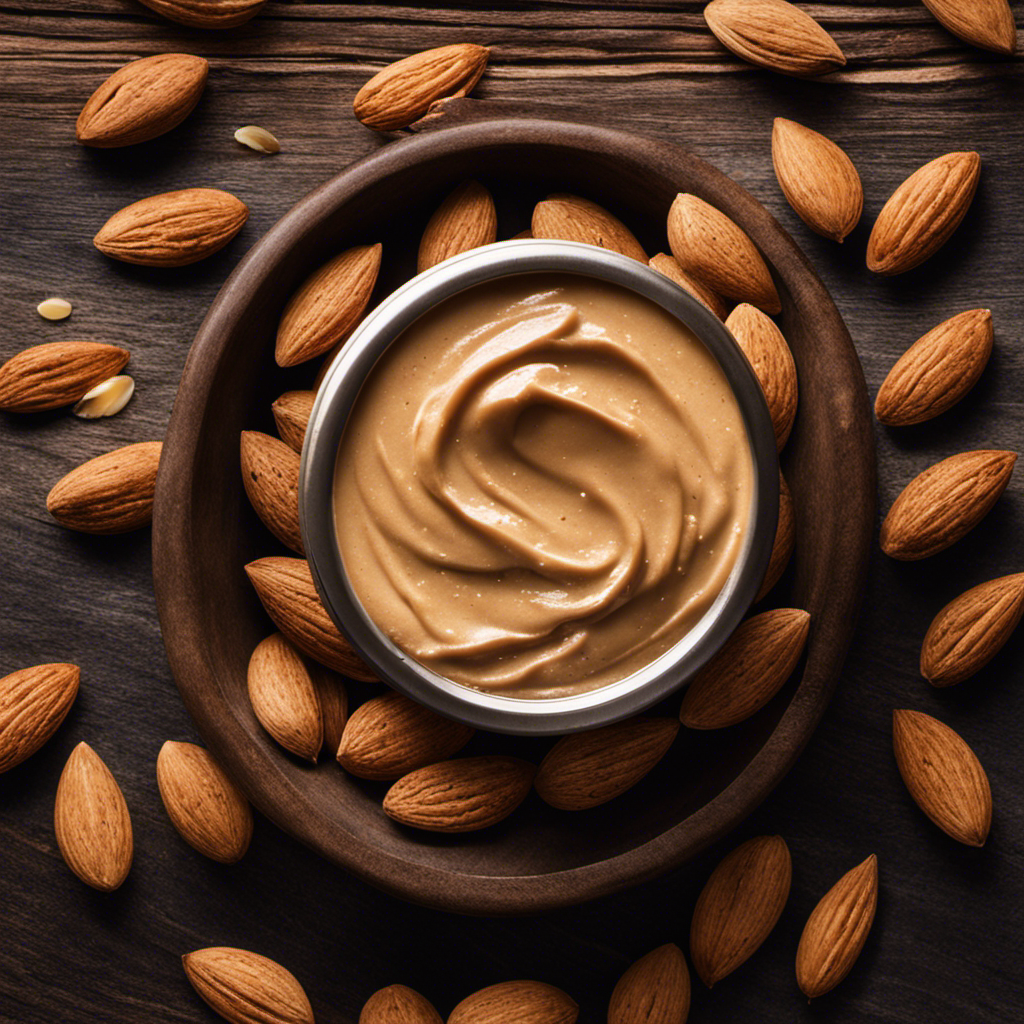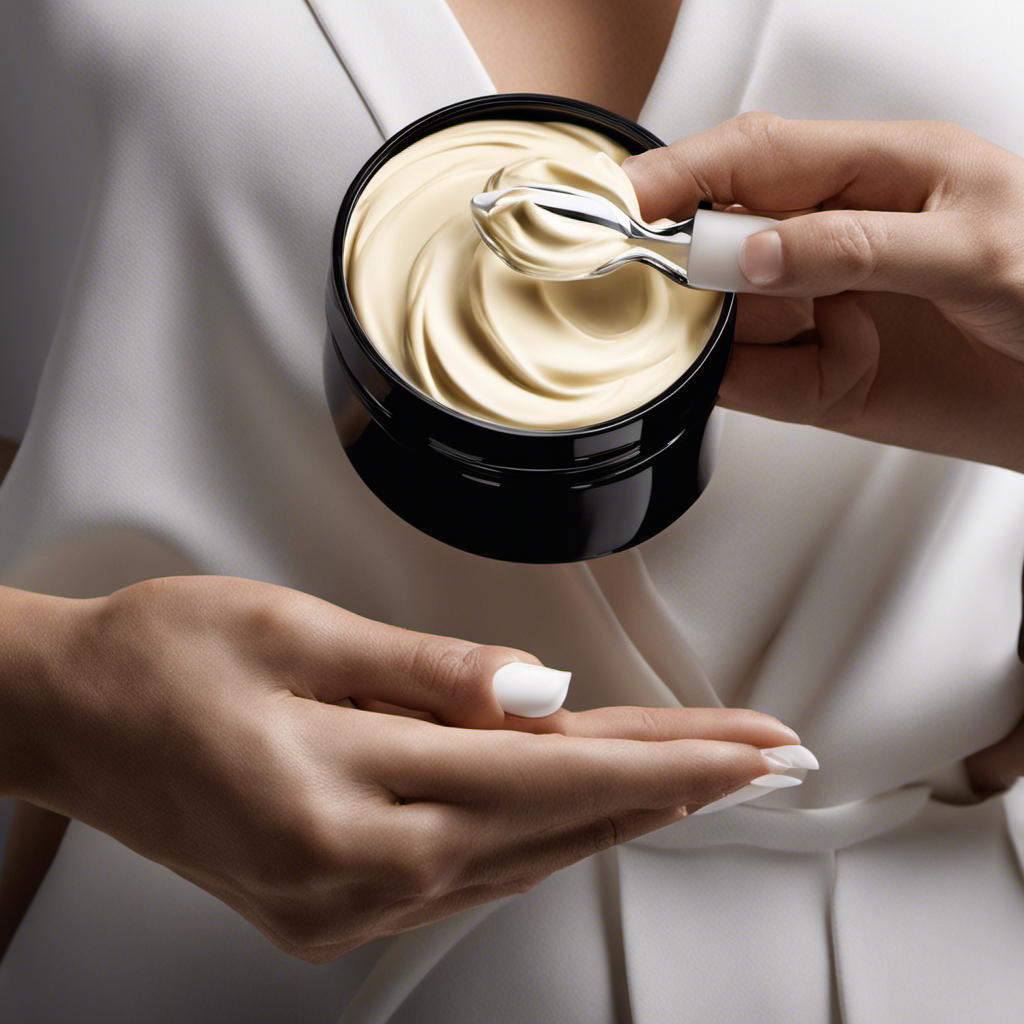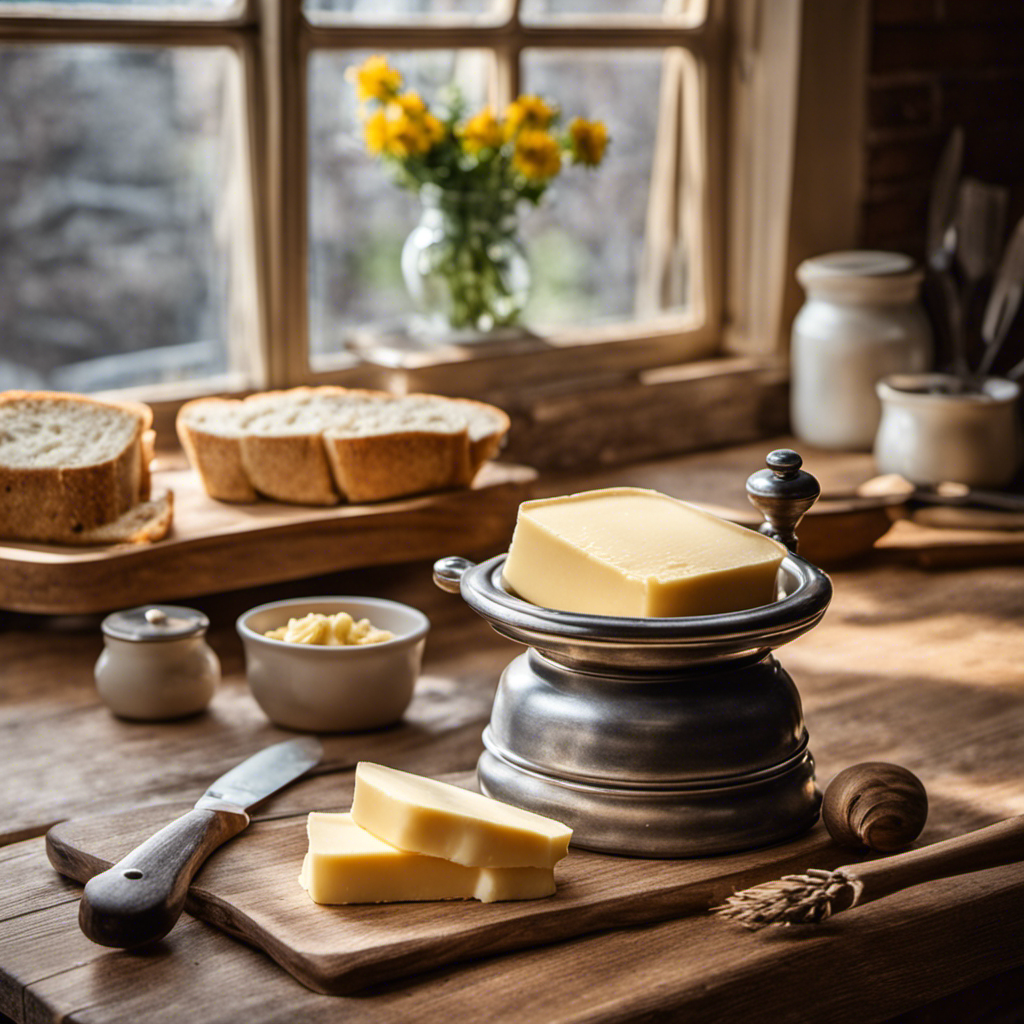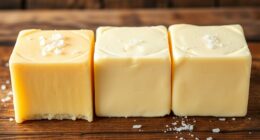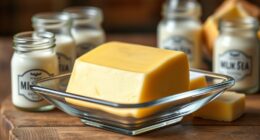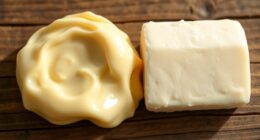There’s no denying that the feeling of smooth, well-moisturized skin is unmatched. And let me tell you, body butter is the secret weapon to achieving it.
Trust me, I’ve tried it all. From dry skin relief to healing properties for eczema or psoriasis, body butter has got you covered.
And with winter just around the corner, it’s time to add this hydrating superstar to your skincare routine.
So buckle up, because I’m about to spill all the tea on when to use body butter.
Key Takeaways
- Body butter is beneficial for dry skin as it provides immediate hydration and nourishment, and forms a protective barrier to prevent moisture loss.
- Body butter has hydrating and nourishing properties, deeply hydrating and replenishing the skin, and leaving it looking radiant and youthful.
- Body butter can be used to soothe and heal dryness and irritation, reduce inflammation and itchiness associated with psoriasis, and provide long-lasting relief for healthier skin.
- In addition to its primary uses, body butter can also be applied to sunburned areas for deep hydration and healing, reduce skin irritation after shaving, lock in moisture after showering, promote skin healing during scar treatment, and provide a relaxing and soothing self-care experience.
Benefits of Body Butter
You’ll love the benefits of body butter for your skin. Body butter is a luxurious and creamy moisturizer that provides intense hydration and nourishment to the skin. It is especially beneficial for those with dry skin, as it offers relief from dryness and helps restore the skin’s natural moisture balance.
The rich and thick texture of body butter allows it to deeply moisturize the skin, leaving it soft, smooth, and supple. The ingredients in body butter, such as shea butter and cocoa butter, are packed with vitamins and antioxidants that promote healthy skin.
Regular use of body butter can improve the appearance of dry, rough, and flaky skin, giving it a radiant and youthful glow. So, why not treat yourself to the wonderful benefits of body butter and give your skin the hydration it deserves?
Dry Skin Relief
For dry skin relief, applying body butter can provide immediate hydration and nourishment. Body butter is a thick and luxurious moisturizer that is specifically formulated to deeply hydrate and nourish the skin.
It is an excellent choice for those with sensitive skin as it is made with natural ingredients that are gentle and soothing. Body butter is also beneficial for aging skin, as it helps to improve the appearance of fine lines and wrinkles, leaving the skin looking smoother and more youthful.
The rich and creamy texture of body butter allows it to form a protective barrier on the skin, preventing moisture loss and keeping the skin hydrated for longer periods of time. Regular use of body butter can help to restore and maintain the skin’s natural moisture balance, leaving it soft, supple, and healthy-looking.
Hydrating and Nourishing Properties
To deeply hydrate and nourish your skin, opt for a thick and luxurious moisturizer like body butter.
Body butter is a fantastic choice for those seeking intense hydration and skin rejuvenation. Its rich and creamy texture is designed to deeply penetrate the skin, providing long-lasting moisture and leaving your skin feeling soft and supple.
The hydrating benefits of body butter are unparalleled, as it helps to replenish and lock in moisture, making it an excellent option for those with dry or dehydrated skin. Additionally, body butter contains nourishing ingredients such as shea butter, cocoa butter, and essential oils, which further contribute to its skin-nourishing properties.
Regular use of body butter can help improve the overall health and appearance of your skin, making it look more radiant and youthful.
Winter Skincare Routine
When it comes to my winter skincare routine, I understand the importance of prioritizing hydration and protection against harsh weather conditions. During the winter months, the cold air and low humidity can leave my skin feeling dry and dull.
That’s why I make sure to incorporate a deeply moisturizing body butter into my daily routine. Body butter is a luxurious and nourishing product that provides intense hydration and helps to repair and replenish the skin’s moisture barrier. It’s formulated with rich ingredients like shea butter and oils that deeply moisturize the skin, leaving it feeling soft, smooth, and supple.
Applying body butter after a warm shower or bath helps to lock in moisture and protect my skin from the cold, dry winter air. It’s a vital step in my winter skincare routine that keeps my skin healthy and hydrated throughout the season.
Healing Properties for Eczema or Psoriasis
Moisturizing with body butter can help soothe and heal eczema or psoriasis, providing relief from dryness and irritation.
Both eczema and psoriasis are chronic skin conditions that can cause discomfort and affect the quality of life.
Body butter, with its rich and nourishing ingredients, can effectively hydrate the skin and create a protective barrier. This helps to retain moisture and prevent further dryness, which is essential for eczema treatment.
The emollient properties of body butter also aid in reducing inflammation and itchiness associated with psoriasis.
The natural oils and butters in body butter, such as shea butter and coconut oil, are known for their healing properties and can help to soothe and repair damaged skin.
Regular use of body butter can provide long-lasting relief and promote healthier skin for those suffering from eczema or psoriasis.
How to Use Body Butter for Sunburn
When it comes to sunburn relief, incorporating body butter into your skincare routine can be a game-changer. Here’s how to use body butter for sunburn:
-
Apply a generous amount of body butter to the affected areas. The rich and creamy formula will provide deep hydration, soothing the burned skin.
-
Gently massage the body butter onto your skin, allowing it to absorb fully. This will help nourish and replenish the damaged skin cells.
-
Repeat the application as needed throughout the day to keep your skin moisturized and promote healing.
Using body butter for sunburn not only provides much-needed relief but also helps prevent peeling and keeps your skin soft and supple. Remember to stay hydrated and avoid further sun exposure.
Now, let’s dive into the next section about post-shaving soothing and moisturizing.
Post-Shaving Soothing and Moisturizing
I’ve found that post-shaving can often lead to skin irritation and dryness. It’s important to use products that can help alleviate these issues.
One such product is body butter. It’s known for its ability to reduce skin irritation and restore moisture balance. Body butter contains nourishing ingredients that promote skin healing, helping to soothe any razor burns or cuts.
Reduces Skin Irritation
To reduce skin irritation, you can apply body butter, which helps soothe and nourish your skin. Body butter is a rich and creamy moisturizer that contains highly hydrating ingredients like shea butter, cocoa butter, and essential oils.
Here are three reasons why body butter is effective in reducing redness and soothing inflammation:
-
Deep hydration: The thick consistency of body butter provides intense moisture to the skin, helping to repair the skin barrier and prevent further irritation.
-
Anti-inflammatory properties: Many body butters contain natural ingredients like aloe vera and chamomile, which have anti-inflammatory properties that help calm and soothe irritated skin.
-
Nutrient-rich formula: Body butter is packed with vitamins and antioxidants that nourish and rejuvenate the skin, promoting a healthy complexion and reducing redness.
Restores Moisture Balance
Applying body butter helps restore moisture balance to the skin, leaving it feeling hydrated and nourished. Body butter is a rich and creamy moisturizer that contains high levels of emollients and nourishing ingredients. When applied to the skin, it creates a barrier that prevents moisture loss and promotes hydration.
The rich texture of body butter allows it to deeply penetrate the skin, providing intense hydration and improving skin texture. It replenishes the skin’s natural oils, which are essential for maintaining a healthy moisture balance. Regular use of body butter can also help improve the appearance of dry and rough skin, making it feel softer and smoother.
This makes body butter an excellent choice for those seeking to restore hydration and improve skin texture. As we delve into the next section, we will explore how body butter promotes skin healing.
Promotes Skin Healing
Promoting skin healing, body butter helps to repair and rejuvenate damaged skin cells. It is a versatile product that can be used for various purposes, including skin rejuvenation and scar treatment. Here are three reasons why body butter is beneficial for promoting skin healing:
-
Deep Hydration: Body butter is rich in nourishing ingredients like shea butter and cocoa butter, which deeply moisturize the skin. This intense hydration helps to restore the skin’s natural moisture balance, making it more resilient and better equipped to heal itself.
-
Nutrient-Rich Formula: Body butter is often infused with vitamins and antioxidants that provide essential nutrients to the skin. These nutrients support the skin’s healing process and help to repair damaged skin cells, promoting faster healing and minimizing the appearance of scars.
-
Protective Barrier: The thick and creamy texture of body butter creates a protective barrier on the skin’s surface, shielding it from external irritants and pollutants. This barrier not only helps to prevent further damage but also allows the skin to heal more effectively.
Overall, incorporating body butter into your skincare routine can greatly aid in the healing and rejuvenation of your skin cells, making it an excellent choice for scar treatment and skin rejuvenation.
Body Butter as a Massage Oil Alternative
As someone who’s always been interested in skincare, I’ve found that body butter offers a multitude of skin-nourishing benefits.
Not only does it deeply moisturize the skin, but it also provides a relaxing and soothing experience.
The rich and creamy texture of body butter allows it to deeply penetrate the skin, leaving it feeling soft, hydrated, and rejuvenated.
Skin Nourishing Benefits
To get the most out of body butter, apply it immediately after showering to lock in moisture and nourish your skin. Body butter offers numerous skin rejuvenation benefits. Here are three reasons why using body butter can help you achieve healthier, younger-looking skin:
-
Intense Hydration: Body butter is formulated with rich, moisturizing ingredients like shea butter and cocoa butter. These ingredients penetrate deep into the skin, providing intense hydration and reducing dryness and flakiness.
-
Anti-Aging Properties: Many body butter formulations contain antioxidants and vitamins that fight against the signs of aging. These ingredients can minimize the appearance of fine lines and wrinkles, leaving your skin looking smoother and more youthful.
-
Nourishment and Repair: Body butter is packed with essential fatty acids that nourish and repair the skin. Regular use can improve the overall texture and tone of your skin, giving it a healthy and radiant glow.
Deeply Moisturizes Skin
Applying body butter after showering deeply moisturizes the skin, leaving it soft and hydrated. Body butter is a thick, luxurious cream that contains high levels of moisturizing ingredients. Its rich and creamy texture allows it to penetrate deeply into the skin, providing intense hydration and nourishment.
Body butter is particularly effective for dry or dehydrated skin, as it helps to replenish and restore moisture levels. The moisturizing properties of body butter come from its key ingredients such as shea butter, cocoa butter, and oils like almond or jojoba. These ingredients create a protective barrier on the skin, preventing moisture loss and locking in hydration.
By incorporating body butter into your skincare routine, you can keep your skin hydrated and maintain its natural moisture balance.
Now, let’s explore how body butter can also be relaxing and soothing for the mind and body.
Relaxing and Soothing
When you incorporate body butter into your skincare routine, you’ll find it to be a relaxing and soothing experience for both your mind and body. The luxurious texture of body butter glides effortlessly over your skin, providing deep hydration and leaving you feeling pampered.
Here are three ways body butter can help you relax and relieve stress:
-
Massage: Take a few minutes each day to massage body butter into your skin using gentle circular motions. Not only will this promote blood circulation, but it will also release tension and promote relaxation.
-
Aromatherapy: Many body butters are infused with calming scents such as lavender or chamomile. These aromas can help calm your mind and provide a sense of tranquility during your skincare routine.
-
Self-care ritual: Incorporating body butter into your skincare routine can become a self-care ritual that allows you to focus on yourself and unwind from the stresses of the day. Taking this time for yourself can promote a sense of well-being and help you recharge.
Frequently Asked Questions
Can Body Butter Be Used on the Face?
Yes, body butter can be used on the face, but there are pros and cons to consider. It can provide intense hydration, but it may be too heavy for some skin types. There are alternatives for facial care, such as lightweight moisturizers specifically designed for the face.
Is Body Butter Suitable for All Skin Types?
Body butter is suitable for all skin types as it provides numerous benefits. It deeply nourishes and moisturizes the skin, making it particularly beneficial for dry skin. It can be used daily for maximum hydration.
Can Body Butter Help Reduce the Appearance of Stretch Marks?
Yes, body butter can help reduce the appearance of stretch marks. It’s one of the many benefits of using body butter for the skin. It provides deep hydration and nourishment, promoting skin elasticity.
Does Body Butter Have Any Anti-Aging Properties?
Body butter can be effective in reducing the appearance of wrinkles and providing anti-aging benefits. I’ve personally seen a noticeable improvement in my skin’s texture and firmness after using body butter regularly.
Can Body Butter Be Used as a Lip Balm?
Body butter can be a great alternative to traditional lip balms. Its rich, moisturizing formula helps nourish and hydrate the lips. It’s a natural lip care option that can provide long-lasting moisture.
Conclusion
In conclusion, body butter is truly a skincare superhero. It has a multitude of benefits, providing relief for dry skin and healing properties for eczema or psoriasis. It’s a must-have in any skincare routine. Whether you’re looking to hydrate and nourish your skin, soothe sunburn, or moisturize after shaving, body butter has got you covered. It’s like a luxurious massage oil alternative that leaves your skin silky smooth.
So, next time you’re in need of some serious skincare TLC, reach for the body butter and let its magic work wonders.

